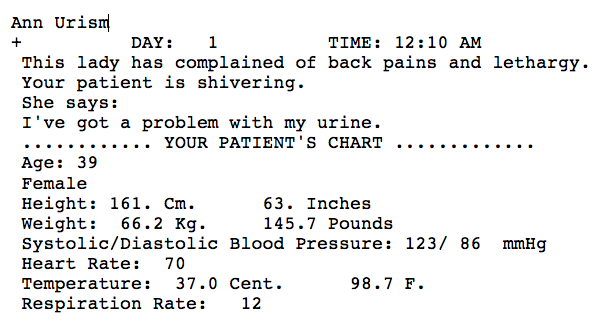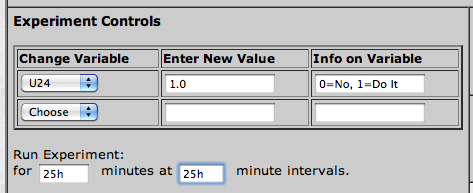Case
- Back pains, shivering, "problem with my urine";
Run me for 10 more days.
Hints page
I. The Case (& preliminary "hints")
Case - Back pains, shivering, "problem
with my urine"; Run me for 10 more days.
II. The Chart
We examine the information revealed in HUMAN by selecting < Your Patient's Chart > ...

... noting that while the vital
signs are largely within normal range there are reports of back
pains and shivering coupled
with a statement of a "problem with my urine. "
... we are also explicitly instructed
to run this patient for ten more days (presumably to more clearly see the
developing pattern of problems).
III.
Running the patient for 10 days to obtain a fuller data set
A] Setup:
The report of urinary problems
leads us to focus on renal function. To do so we choose output variables and tests that yield information targeted to renal function.
A-1] Choosing output variables
to display
Variables: Change View
output: to
show a selection of renal-related variables, (see below) especially
those that will not show up readily on <Patient
Charts or Lab tests>.

These are, left to right,
mean arterial pressure (AP), blood urea nitrogen, excretion of urea
(mg/min), an acid-base profile [ blood arterial pH, plasma BICARBonate
and total lung ventilation.
A-2] Choosing Charts and
Tests to display
Charts:
We request <Patient
chart..> that
shows a Kidney
Summary. (see immediately below)

B] Results:
We now run the model for 10 days
(10d) with 1 day (1d) between printouts to observe developing trends.
B-1] Pattern
of the physiological variables

Some trends in the above data
to think upon here include
• what do the blood urea nitrogen
and kidney urea excretion patterns suggest about renal function?
• what do the pH, bicarbonate
and ventilation patterns suggest about the acid/base situation and
therefore renal function?
We also now run and compare
the Kidney Summary chart at day 10 with that of a "normal" subject
(run a Physiological experiment to obtain Mr. Norm L.
Subject's Kidney chart).
B-2] Patterns in the patient's
kidney chart

Some items in the above data
to think upon include
• Is this a normal Glomerular
Filtration Rate (GFR) and if not, what consequences might this have
for renal function?
• Are the rates of water excretion
(EXH2O) and urea excretion (EXUR) normal?
• Does protein normally appear
in the urine in these amounts?
• Acid handling- are these
normal values for renal acid excretion rate and urine pH?
C] Another approach - obtain
urine samples
Note
that a somewhat
different approach can be taken to characterizing possible renal
problems by asking for kidney data via urine samples. While
we do not do so here, how to do so is illustrated briefly below.
- ask for a 24 urine collection (set up left, request on the right)
or
- ask for a series of
urine specimens (below)

IV. More
This ends the hints section on this case.
You should attempt again at this point to arrive at a diagnosis and a treatment. To do so
• Return to the HUMAN model's
Physiology Lab section for this patient and verify
- the diagnosis by finding the appropriate variables to support your argument and
- the treatment by changing parameters so as to stabilize the patient.
V. Analysis
If you wish further analysis and a diagnosis on
this case and information on how it was created, click on this link ( analysis ) and log in as requested.
* Note: Case hints and analyses are based heavily on Drs. Randall and Coleman's HUMAN-80 Instructor's Manual supplemented by notes of Dr. Coleman's in the model code itself and findings by myself and other colleagues over our years of use of these cases.





